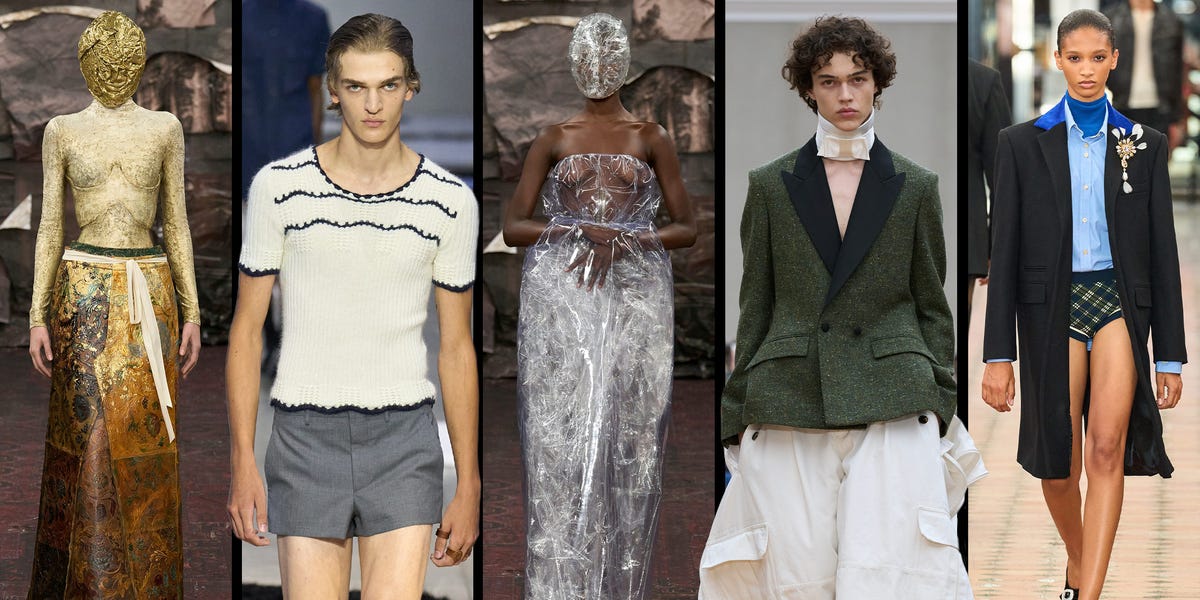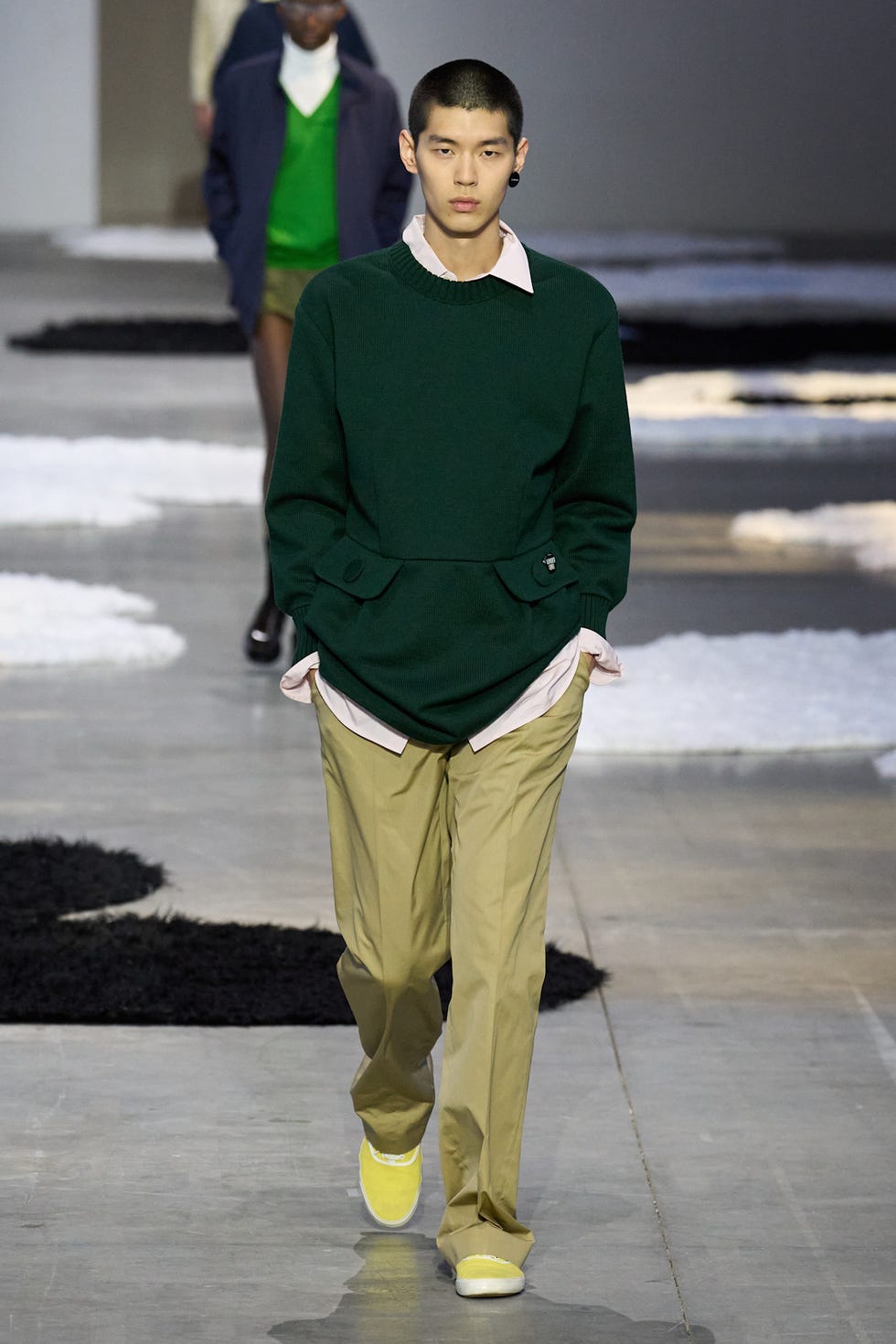E Pluribus Unum—“Out of many, one.” A motto of national cohesion, strangely bureaucratic, is engraved outside the Midtown Tunnel. I saw it through the back window of a cab, blurred by the city’s summer heat shimmer, and thought about its inverse: “E Unibus Pluram,” which happens to be the title of an essay by David Foster Wallace. Written in 1993, a few years before the publication of his great-American-novel-attempt Infinite Jest, the essay explores a new generation’s rejection of irony in literature and art and its move towards a more sincere, straightforward view of culture. Through this, Wallace hoped for a more unified vision, versus a kind of multiplicity of ideas and open-ended interpretation. He feared mass reproduction and embraced emotion. This was the gospel of the New Sincerity Movement then, but today, I see a glaring connection to fashion.
Ever since “E Unibus Pluram” popped back into my brain, I’ve been connecting the dots between the current fashion zeitgeist and Wallace’s own trend forecasting of what the new “cool” was three decades ago. “The new rebels,” Wallace wrote in his essay, “might be the ones to risk the yawn, the rolled eyes, the cool smile, the nudged ribs, the parody of gifted ironists, the oh-how-boring.” His call for a new generation of rebels who would “risk the yawn” can be seen in the work of today’s most buzzworthy designers.
Think about the way luxury fashion has changed over the past 20 years, from Tom Ford’s sexy Gucci to Alessandro Michele’s kooky Gucci; from Nicolas Ghesquiere’s classy-futurist Balenciaga to Demna’s deconstructivist Balenciaga. Both examples highlight a visible sartorial shift from Postmodernism to New Sincerity. Wallace’s “new” rebels aren’t so different from the fashion world’s perennial muse: the misunderstood visionary, the designer who rejects convention. Wallace wanted to be cool on his own terms: not through detachment, but by being visibly, painfully invested. Applying his logic, Tom Ford’s Gucci or Ghesquiere’s Balenciaga would be the postmodernists. Whereas the garments made by their successors are earnest—or at least are made to look that way, like Michele’s Gucci eyeglasses neckchain or Demna’s massive Balenciaga dad sneaker. They’re sincere in their verisimilitude to the style of real people, of grandmas in reading glasses and dads in dorky footwear.
During this two-decade shift, fashion archetypes went from unattainable to hyperattainable—from power suits and robot-like platform sandals to designer bifocals and chunky orthopedic shoes. That same paradox drives the most interesting movements in fashion today. Sincerity has become the new posture, not despite its complications but because of them.
Fashion has a unique ability to joke. Look at Demna’s final collection for Balenciaga during couture earlier this month, where he revealed the central concept at the heart of his more rabble-rousing silhouettes at the Parisian house: identity construction through exaggerated “normcore” shapes like sneakers and hoodies. These types of trend-spreads mimic the one-becomes-many idea of “E Unibus Pluram.” However, couture presents a counterargument. What about when fashion celebrates craft and tradition during couture week? The fall 2025 couture season and spring 2026 menswear shows made the case more forcefully than ever: not only is this fashion earnestly about emotion, but it dares to make artifice itself the vector for feeling. Fashion can elicit a feeling because it is constructed, not in spite of reproducibility; a new shape or silhouette is an innovation that challenges what we wear day-to-day. Right now, we are not just witnessing a “new sincerity” in fashion; we are watching the industry wrestle with what sincerity is.
When Glenn Martens unveiled his first couture collection for Maison Margiela during the Fall 2025 season, there was a collective breath held across the fashion industry. Would he tip into homage or shatter the mirror entirely? The answer was somewhere in between, which is precisely why it worked. There were the crushed and crinkled gowns (metallic, oxidized textures that looked more excavated than sewn), but it was the return of the masks at the label that carried the most weight. The masks called back to the brand’s founding mythology: Martin Margiela’s Spring/Summer 1993 show, where anonymity was a declaration of interiority, rather than evidence of being silenced.
But Martens’s masks were different. These are masks about masks. A reference to a reference. And yet, they’re startlingly sincere. In couture, which by nature resists commercial dilution, there’s permission to play at the boundaries of absurdity, and through that, to reveal something raw. Martens’s intent with the reference was not to plagiarize; it was to declare lineage. This is an earnest mask, one that doesn’t protect or hide but intensifies gaze. In a sense, Martens delivers what Wallace feared couldn’t exist: a deep sincerity communicated through pastiche.
In the Fall 2025 menswear collections, like Wales Bonner’s “Jewel” and Jonathan Anderson’s highly-anticipated debut at Dior, references presented themselves in earnest, sometimes gilded in bejeweled pins or calling back to 1950s house codes. Sincerity became an active process displayed on the runway. At Prada, Raf Simons and Miuccia Prada have always proposed a vision of identity built from contradiction, where classic tailoring is disrupted by mismatched fastenings, layered textures, and asymmetrical silhouettes, a kind of elegant messiness that suggests coherence born from personal chaos. That through-line of emotional vulnerability extended into their menswear show this season, which embraced softness in its most literal and figurative forms: gauzy knits, boyish shorts, and gently oversized outerwear that conjured the image of the modern softboy, not as trend but as emotional archetype. There is a distinct sincerity in their approach, in using the structure of menswear to reimagine the contours of masculinity itself.
To challenge the late Wallace: What if multiplicity isn’t a death sentence? What if, at least as far as fashion goes, it’s a gift?
Designers like Martens, Anderson, Wales Bonner, Mrs. Prada, and Simons, aren’t followers in the way Wallace forecasted. They’re not passive consumers of mass media tropes. Or, not just that; group thinking is a cornerstone of the trend economies that make what’s in fashion, well, in fashion. These designers are thinkers, earnest ones at that. We’re seeing the visual language of reference deployed not as a way to flatten meaning, but to layer it. Sometimes it’s the most artificial garments—the mask, the geeky pair of eyeglasses, the charm-laden sweater—that deliver the deepest emotional truths.




